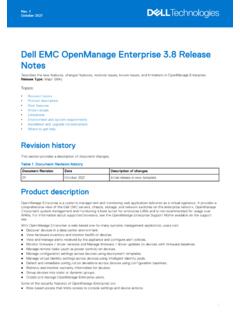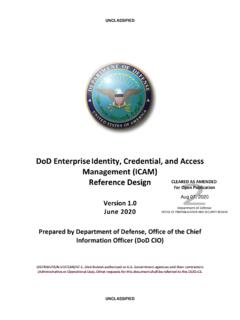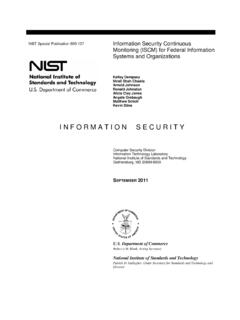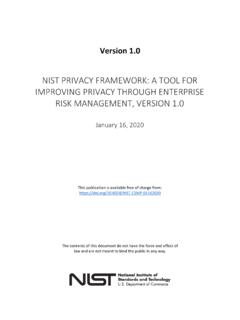Transcription of Metrics and Performance Measurement System for the Lean ...
1 Metrics and Performance Measurement System for the Lean Enterprise Professor Deborah Nightingale October 24,2005 Overview Metrics and Performance Measurement Why measure? What is Performance measure? What are good Metrics ? Performance Measurement and Lean Transformation Current practices and Performance Measurement frameworks Performance Measurement System for the lean enterprise / : Integrating the Lean Enterprise Deborah Nightingale, 2005 Massachusetts Institute of Technology Page 2 Why Measure? Performance control systems can serve two purposes, to measure and to motivate. - H. Mintzberg, The Structure of Organizations, 1979 The firm becomes what it measures - Hauser and Katz, You are What You Measure, 2002 Metrics serve multiple purposes!
2 Strategy Feed Decision Back Making Measures Outcomes Actions Robert Nixon (1990) / : Integrating the Lean Enterprise Deborah Nightingale, 2005 Massachusetts Institute of Technology Page 3 What is Performance Measurement ? Performance Measurement is the process of measuring efficiency, effectiveness and capability, of an action or a process or a System , against given norm or target. Effectiveness is a measure of doing the right job - the extent to which stakeholder requirements are met. Efficiency is a measure of doing the job right - how economically the resources are utilized when providing a given level of stakeholder satisfaction.
3 Capability is a measure of ability required to do both the job right and right job, in the short term as well as the long term. This can be tangible, such as, resources, technology, or intangible, such as a corporate culture. / : Integrating the Lean Enterprise Deborah Nightingale, 2005 Massachusetts Institute of Technology Page 4 Characteristics of good Metrics Metrics are meaningful, quantified measures Metric must present data or information that allows us to take action Helps to identify what should be done Helps to identify who should do it Metrics should be tied to strategy and to core processes - indicate how well organizational objectives and goals are being met Metrics should foster process understanding and motivate individual, group, or team action and continual improvement.
4 / : Integrating the Lean Enterprise Deborah Nightingale, 2005 Massachusetts Institute of Technology Page 5 Broad Criteria A Good Metric Satisfies Three 1. Strategic Enable strategic planning and then drive deployment of the actions required to achieve strategic objectives Ensure alignment of behavior and initiatives with strategic objectives Focus the organization on its priorities 2. Quantitative Provide a clear understanding of progress toward strategic objectives Provide current status, rate of improvement, and probability of achievement Identify Performance gaps and improvement opportunities 3.
5 Qualitative Be perceived as valuable by your organization and the people involved with the metric / : Integrating the Lean Enterprise Deborah Nightingale, 2005 Massachusetts Institute of Technology Page 6 Metric Elements Metric Elements Title Objective/purpose Scope Target Formula Units of measure Frequency Data source Owner Comments Explanation Use exact names to avoid ambiguity The relation of the metric with the organizational objectives must be clear States the areas of business or parts of the organization that are included Benchmarks must be determined in order to monitor progress The exact calculation of the metric must be known What is/are the unit(s)
6 Used The frequency of recording and reporting of the metric The exact data sources involved in calculating a metric value The responsible person for Performance of that part of the organization, collecting data and reporting the metric Outstanding issues regarding the metric Adapted from Neely, A., et al. (1995a) Performance Measurement System design. 15, 80. / : Integrating the Lean Enterprise Deborah Nightingale, 2005 Massachusetts Institute of Technology Page 7 Role of Performance Measurement Monitoring Measuring and recording actual Performance Control Identifying and attempt to close the gap between planned target and actual Performance Improvement Identify critical improvement opportunities Coordination Information for decision making Leading Indicators Internal communication across processes External communication with stakeholders Motivation Align Behavior and encourage transformation Source: Vikram Mahidhar /.
7 Integrating the Lean Enterprise Deborah Nightingale, 2005 Massachusetts Institute of Technology Page 8 Deborah Nightingale, 2005 Massachusetts Institute of / : Integrating the Lean EnterprisePage 9 Transformation to the Lean EnterpriseFunctional Enterprise654321712233654321712233654321 7112233 SalesEngineeringManufacturingPurchasingR &DValue DeliveryStakeholder ObjectivesCustomerEmployeesSuppliersShar eholdersCommunityEnterprise Leadership &Governance ProcessesEnabling InfrastructureProcessesLifecycle ProcessesProcessesSalesCUSTOMERC enters of ExcellenceCEO Executive boardEngineeringManufacturingR&DProcess EnterpriseLean EnterpriseSource.
8 Vikram MahidharMetrics Challenge Today Hierarchical organizational architectures giving way to networked enterprise architectures The evolving structure and dynamics ofnetworked enterprises display immensecomplexity Metrics response to such complexity has been adisappointment: Hierarchical Metrics mindset still continues Response to greater complexity has been a Metrics explosion Challenge: How best to design Metrics systemsfor networked enterprises? / : Integrating the Lean Enterprise Deborah Nightingale, 2005 Massachusetts Institute of Technology Page 10 Deborah Nightingale, 2005 Massachusetts Institute of /.
9 Integrating the Lean EnterprisePage 11 ROIC = Return on Invested CapitalORPIC* = Operational Readiness per Invested CapitalPerformance Measurement System for Lean TransformationTransformation over TimeTransformation over TimeKnowledge and BehaviorMetrics and AssessmentsNew approaches (training and introduction of new methods)Engagement in LAI-venue with like-minded peopleEnterprise simulation, Lean Now and LAI knowledge area teamsLocal efforts and new capabilities Industry GovernmentSkills, training hours, certification, lean deployment, joint assessments and effortsNew local behaviorShift in thinking and behaviorNew routines and ways of doing businessOrganization and group culture changeCycle time, quality, WIP, on-time delivery, customer satisfaction, employee turnover and attitude.
10 Organizational climate and LESAT maturityLocal results and visible indicators Industry GovernmentNew enterprise capabilityIntegration of processes/methods & tools supporting transformation across the value stream enabling new enterprise capabilitiesROICE nterprise impact and resultsIndustry GovernmentORPICA dapted from : Noel Nightingale, 2004 Generic Enterprise Management Process Value delivery Management Assessment jShareholder Value Customer Satisfaction Employee Satisfaction Other stakeholders Strategy Formulation - Competitive Intelligence - Internal Assessment Strategic and Operational Planning Resource Allocation Plan Strategy Execution Cascaded Ob ectives VSM and Project Prioritization Performance Mgmt Process Communication Operations Balanced Score Cards Operations Management Financial Management Human Resource Information Systems External Environment /.
















